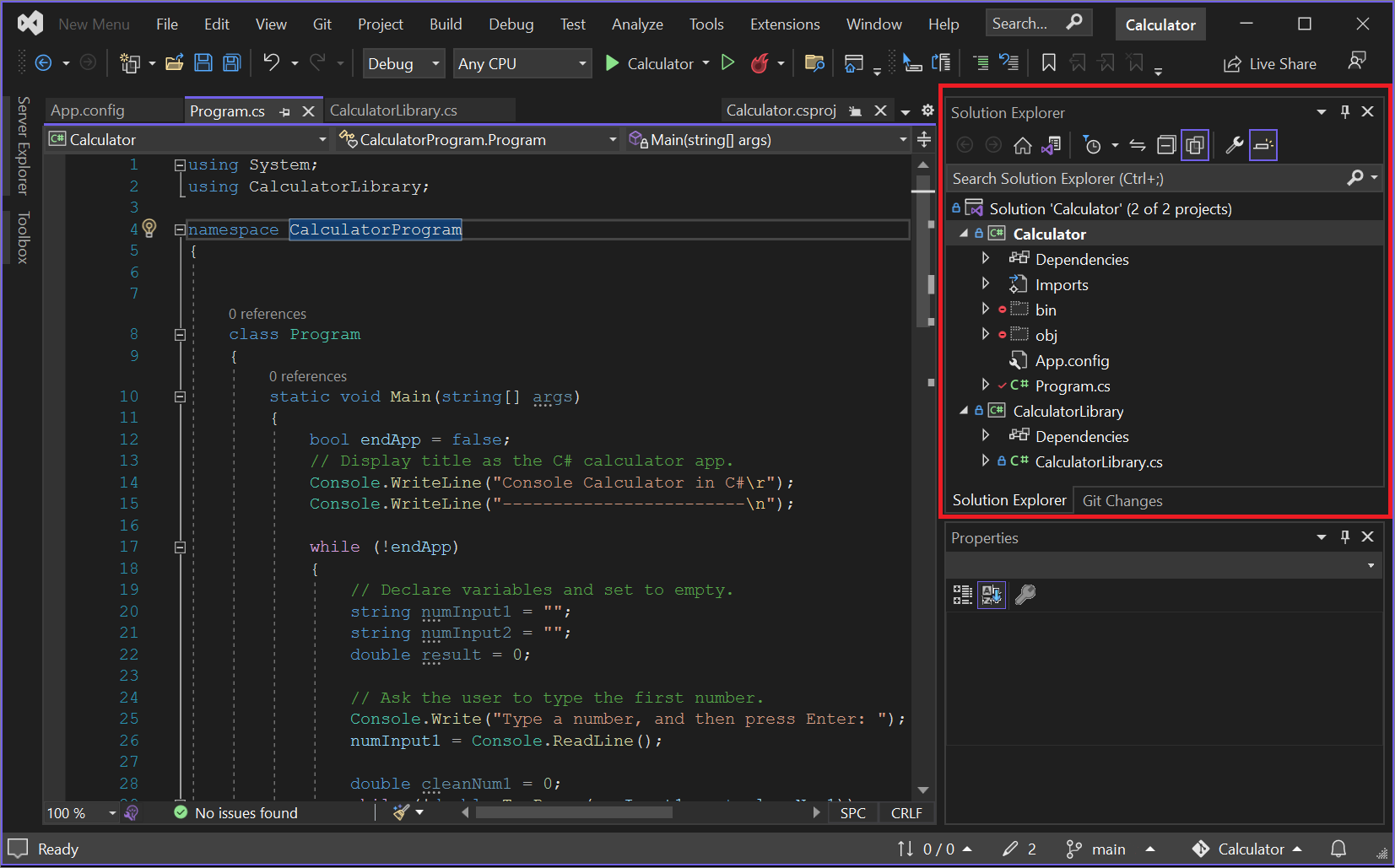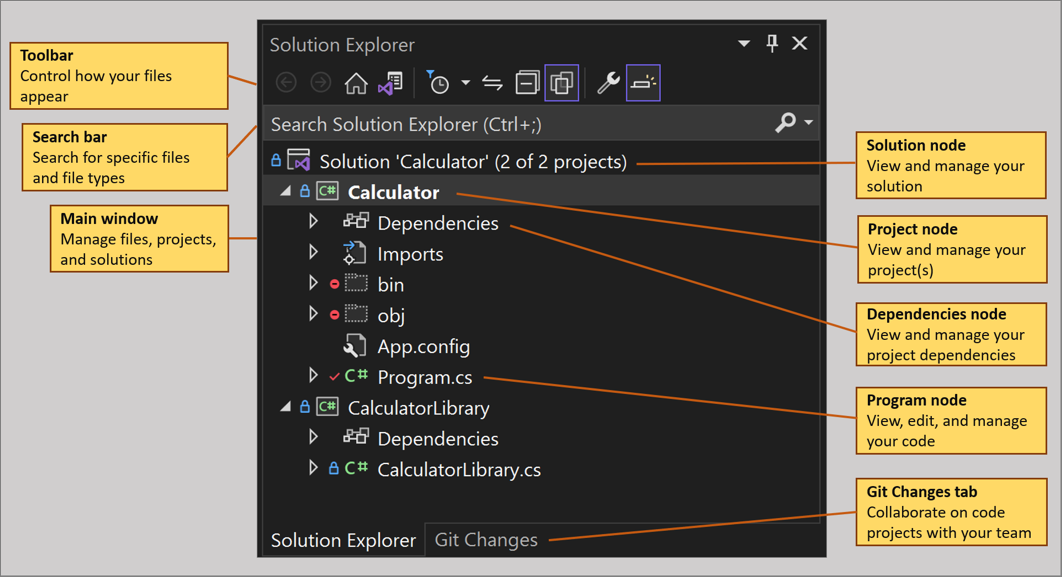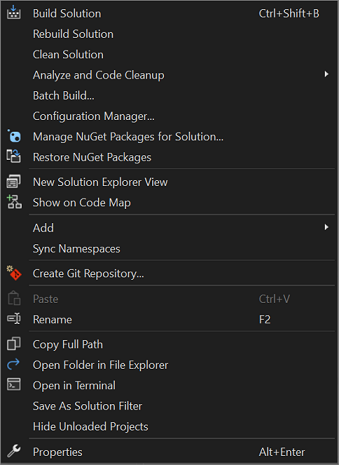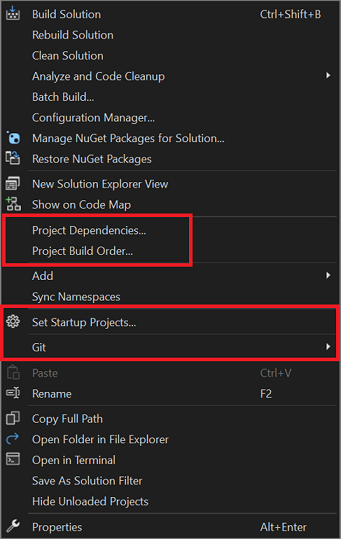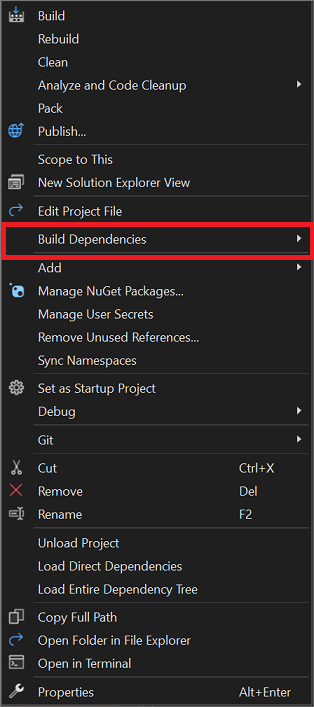Learn about Solution Explorer
You can use Solution Explorer to manage the projects and files within a solution. This article describes the Solution Explorer user interface (UI) in detail, and how to open Solution Explorer if you inadvertently close it. The article also describes how you can use right-click context menu in Solution Explorer to quickly add new files, folders, and code elements to a project.
Open Solution Explorer
By default, the Solution Explorer tool window appears as a pane in the upper-right side of the Visual Studio integrated development environment (IDE). If you don't see the Solution Explorer tool window, you can open it from the Visual Studio menu bar by using View > Solution Explorer, or by selecting Ctrl+Alt+L.
Solution Explorer UI
Let's take a look at the Solution Explorer tool window and its UI (user interface). We'll start with an annotated screenshot of an open C# console solution that has two projects.
The following table is a text-equivalent of the annotated screenshot, but with a few handy links you can use to learn more.
| UI element | Action |
|---|---|
| Toolbar | Control how your files appear |
| Search bar | Search for specific files and file types |
| Main window | View and manage your files, projects, & solutions |
| Solution node | Manage your solution(s) |
| Project node | Manage your project(s) |
| Dependencies node | Manage your solution & project dependencies |
| Program node | View, edit, and manage your program or application (app) |
| Git Changes tab | Use Git & GitHub within Visual Studio to collaborate on projects with your team |
Solution Explorer toolbar
To continue, let's take a closer look at the toolbar in Solution Explorer.

The toolbar contains the following UI elements, from left to right:
| UI element | Action |
|---|---|
| Back button | Toggle between search results |
| Forward button | Toggle between search results |
| Home button | Return to the default view |
| Switch Views button | Switch between the default Solution view and the optional Folder view |
| Pending Changes Filter button & drop-down menu | View open files or files with pending changes |
| Sync with Active Document button | Locate a file from the code editor |
| Refresh button (conditional) | Appears only when you select a dependency, such as a function or a package |
| Collapse All button | Collapse the file view in the main window |
| Show All Files button | View all files, including unloaded projects |
| Properties button | View and change settings for specific files and components |
| Preview Selected Items button | View a selected file or component in the code editor |
Solution Explorer search bar
Let's take a closer look at the search bar in Solution Explorer.
You can use the dropdown in the search bar and select from the Search options: Search within file contents and Search within external items, to scope your search.

Solution Explorer context menu
In Solution Explorer, there are several options that you can interact with by using the right-click context menu. The context-specific options that appear depend on whether you select a Solution node or a Project node.
Solution node menu options
The following screenshot for a C# console app shows the context menu options that appear when you right-click the Solution node.
What you see in the context menu from the Solution node also depends on your project type, programming language, or platform. The following screenshot highlights the following extra options for a C# app: Project Dependencies, Project Build Order, Set Startup Projects, and a Git fly-out menu. These extra options typically appear when you add another project to a solution and then add it to a repo.
Project node menu options
The following screenshot for a C# console app shows the context menu options that appear when you right-click the Project node.
What you see in the context menu from the Project node also depends on your project type, programming language, or platform. The following screenshot highlights the following extra option for a C# app: a Build Dependencies fly-out menu. Extra options typically appear when you add another project to a solution and then add it to a repo.
The Add menu
In the Solution Explorer context menu, one of the most useful options is the Add fly-out menu. From it, you can add another project to a solution. You can also add an item to a project, and more.
You can view the Add fly-out menu from either the Solution node, the Project node, or the Dependencies node. The options vary, depending on which node you use.
For a tutorial that walks you through how to add items and projects by using the context menu in Solution Explorer, see the Introduction to projects and solutions page.
The Quick Add dialog
Starting with the Visual Studio 2022 version 17.5 release, you can use the Quick Add dialog to create an empty file or a simple C# class. In Solution Explorer, right-click on a folder or project and then select Add > New Item. Or, if you prefer, use the Ctrl+Shift+A keyboard shortcut.

With Quick Add, you can perform the following tasks.
- Add a new file without browsing through the template list.
Example: MyClass.cs - Create nested folders in a single operation.
Example: Folder1/Folder2/, Folder1/Folder2/MyFile.cs - Add files with any extension, or with no extension at all.
Example: File.MyExtension, README, .gitignore- Quick Add populates a default extension for you, but you can select Escape (Esc) after you open the dialog to quickly clear the input box.
- Add multiple files at one time.
Example: File1.cs, File2.html or File.cs, File.txt.
You can also quickly switch between the Quick Add dialog and New Item dialog. Here's how.
Use Show All Templates to open the New Item dialog.

Use Show Compact View to open the Quick Add dialog.

Visual Studio remembers your choice so that you get the experience that best suits your needs. If you'd like to return to the default Quick Add dialog, select Shift+F2.
Tip
You can configure the keyboard shortcuts for the Project.AddNewItem command and the AddQuickFile command from Tools > Options > Environment > Keyboard.
The file comparison tool
Starting with the Visual Studio 2022 version 17.7 release, you can now select two files in Solution Explorer and compare them by using the new Compare With and Compare Selected options.
You can compare files in the following ways:
- Right-click a single file, select Compare With… from the context menu, which opens File Explorer. Then, navigate to any file and select it for comparison.
- Multi-select two files by holding down the Ctrl button. Then, right-click and select Compare Selected from the context menu.
No matter which way you choose to compare your files, the file comparison tool should make it easier to compare your files without having to leave your IDE.
The Collapse All Descendants command
Also included with the Visual Studio 2022 version 17.7 release is the Collapse All Descendants command. This command recursively collapses all nodes under a selection so that you can tidy up deeply nested hierarchies as you navigate your project structure.

You can find the Collapse All Descendants command on the right-click context menu for any item in Solution Explorer that has descendants. You can also press Ctrl+Left Arrow to use the command.
Related content
Feedback
Coming soon: Throughout 2024 we will be phasing out GitHub Issues as the feedback mechanism for content and replacing it with a new feedback system. For more information see: https://aka.ms/ContentUserFeedback.
Submit and view feedback for
